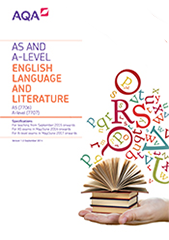3.2 Exploring conflict
This part of the subject content focuses on how language choices help to construct ideas of conflict between people, and between people and their societies.
Students learn about the ways in which writers and speakers use language, beginning with a general focus on broad questions such as:
- How do people interact?
- How do people claim power and position others in talk?
- How do people express identity?
- What communicative strategies do people use when in conflict with others?
- How do different groups or individuals make themselves heard?
Drawing both on their everyday experiences of interaction in different modes and on published texts, students learn about how the language choices writers make are used to express relationships, drive narrative, and construct views about the nature of different societies. They apply their knowledge to the study of texts about individuals in situations of conflict. Students:
- produce re-creative work that seeks to find an absent or underplayed perspective in the original text
- write a critical reflection on the processes and outcomes involved in re-creative work
- study drama that explores conflicts at different levels from the domestic to the societal.
Methods of language analysis
In working on this part of the subject content, students will learn about methods of language analysis. They will be required to adopt a close language focus, identifying salient features of language used in the respective texts.
The following list is a guide to the areas of language analysis students are expected to be familiar with:
- phonetics, phonology and prosodics – for example, how aspects of spoken language are produced and interpreted
- lexis and semantics – for example, the different connotations of terms of address
- grammar – for example, how structural features express characters’ attitudes
- pragmatics – for example, the assumptions made about listeners/readers by the speaker’s/writer’s language choices
- discourse – for example, the conventions of drama texts.
Writing about society
Students study one of four texts.
| Author | Text |
|---|---|
| Jon Krakauer | Into the Wild |
| Kate Summerscale | The Suspicions of Mr Whicher: or the Murder at Road Hill House |
| F. Scott Fitzgerald | The Great Gatsby |
| Khaled Hosseini | The Kite Runner |
In this part of the subject content, students explore the ways that writers:
- present people, their points of view and their relationships with others
- shape the narrative structure and present events/time/places
- reveal the speech and thought processes of the characters and narrator(s)
- use situations of conflict to express ideas about societies and their values.
In addition, students develop the skills to adapt and shape the original material (the base text) to respond to different re-creative tasks. These skills include awareness of:
- the nature of monologue and dialogue
- how changing point of view, genre, context, purpose, audience or mode can re-shape meanings
- how undeveloped aspects of the narrative and characterisation might be developed further
- the importance of specific moments in time or descriptions of place.
Re-creative work seeks to find absent or underplayed perspectives in the base text – for example, the voice of a marginal character, or how an event might have been reported to a different audience – and create a new text in order to enrich the critical reading of the original.
This section of paper 2 is open book. Students may take a copy of their set text(s) into the exam. These texts must not be annotated and must not contain additional notes or materials.
Critical commentary
Drawing on their studies in 'Writing about Society', students learn how to write a critical commentary to evaluate their writing. They explain their own language choices and analyse their intentions in reshaping the writer’s original material.
Students develop the skills to explain the what, the how and the why of the construction of the new text, focusing on the critical decisions made to achieve it and the adaptation of the base text. The aim is to demonstrate conceptual understanding of the choices made and the effects created, as well as demonstrating an understanding of the original text. This might include an exploration of why the original writers made the choices in order to present characters, scenes and events and how these had to be adapted for the student’s own text.
Dramatic encounters
Students study one of four texts.
| Author | Text |
|---|---|
| William Shakespeare | Othello |
| Arthur Miller | All My Sons |
| Tennessee Williams | A Streetcar Named Desire |
| Rory Kinnear | The Herd |
In this part of the subject content, students explore the ways that conflicts are presented, the meanings that can be inferred from the language use and the contextual reasons for these conflicts. As part of their study, students analyse areas relevant to the study of drama and dramatic discourse, including how playwrights:
- represent natural speech features
- use language to create distinctively different characters
- show characters asserting power and positioning others via their language and behaviour
- use the idea of conflict to create dynamic narratives and address the wider themes of the play.
This section of paper 2 is open book. Students may take a copy of their set text(s) into the exam. These texts must not be annotated and must not contain additional notes or materials.
